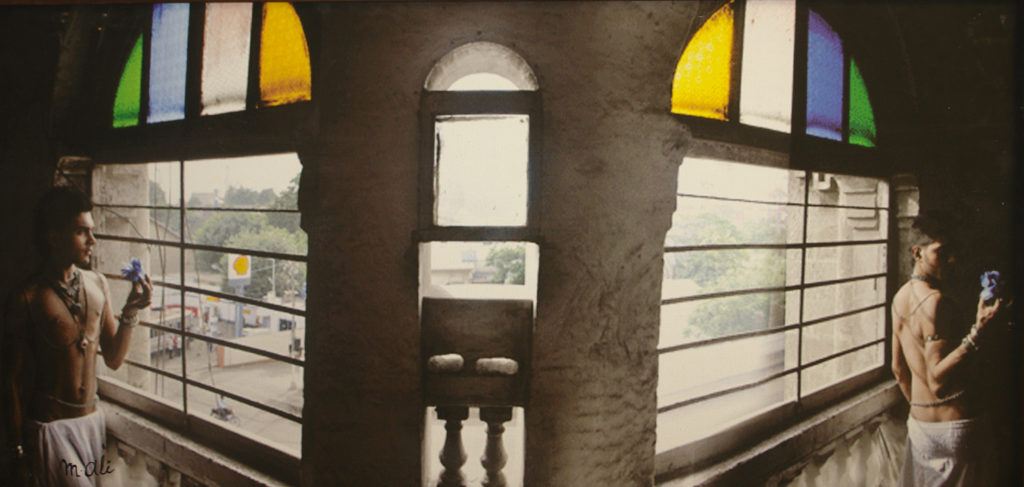By Saba Imtiaz
Amid a sea of attendees at an event marking the anniversary of former Prime Minister Zulfikar Ali Bhutto’s death last year, one woman stood out. On her bright tunic in the red, black and green colors of the flag of Bhutto’s party—the Pakistan Peoples Party—she had embroidered a vivid image of his daughter, Benazir, also a former prime minister.
That form of expression—a veritable ‘wearing your heart on your sleeve’—has long been present in the country. Artists have used their work to express their anguish since the creation of Pakistan in 1947, taking their cue from the bloodshed of partition that led to this country’s formation and its divisions.
But while their anguish may always have existed on canvas, their work has now been given a new lease of life. The intense international media spotlight on Pakistan—brought on by the events of 9/11 and the ensuing war in Afghanistan and surge in militancy in Pakistan itself—has made these works the subject of discussion not just in Pakistan’s small art milieu, but around the world. In the past decade, artists like Imran Qureshi and Rashid Rana—who has exhibited at the Musee Guimet in France—have been celebrated in some of the world’s best galleries, and garnered interest from the likes of Christie’s. This summer, the Metropolitan Museum of Art in New York commissioned Qureshi to create an installation for the museum’s rooftop garden. His work used splatters of red paint to form visuals in the style of the miniaturists whose work is characteristic of this region. Qureshi’s own miniatures are currently on display at the Met.
While Qureshi or Rana don’t focus exclusively on violence in their work, the annual theses exhibits at Karachi’s art schools seem largely dominated by the conflict in the country. From a tree hung with grenades to car window shades beseeching muggers not to shoot, it is hard to shake off the sense that the headlines have permanently entrenched themselves in the consciousness of Pakistani artists.
Sameera Raja, who runs the contemporary art gallery Canvas in Karachi, attributes this to an awareness of Pakistani art. It isn’t just restricted to galleries anymore, images of Pakistani art have gone viral and there is far more press coverage at home and abroad.
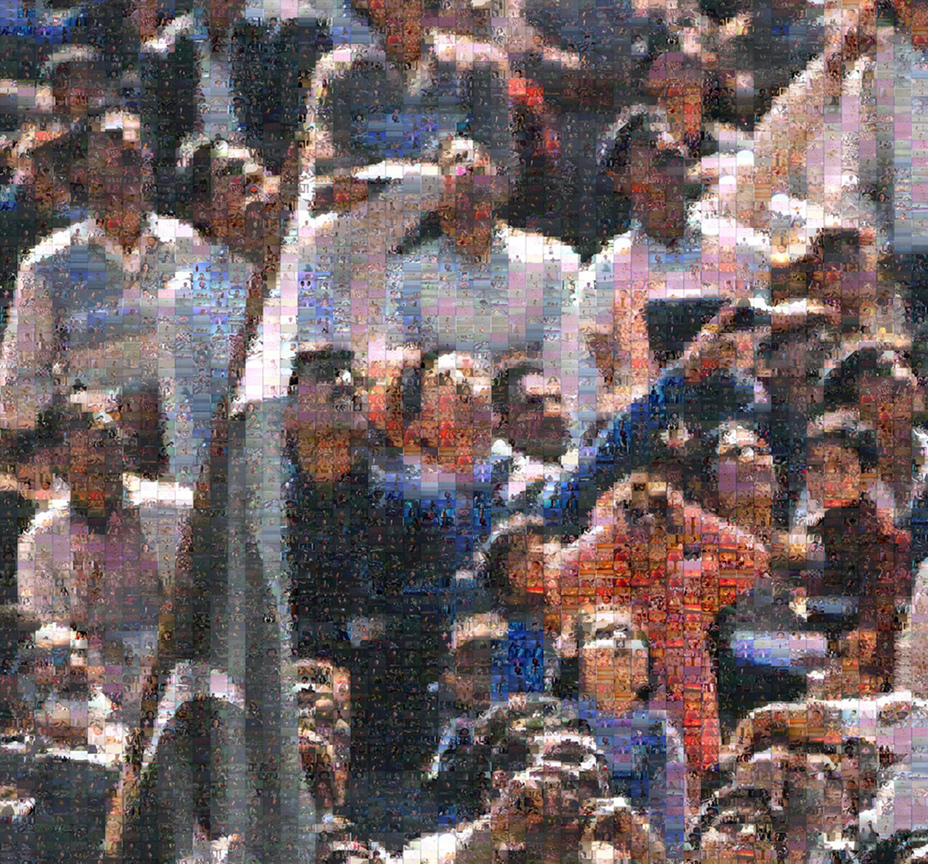
Rashid Rana, detaila from “All Eyes Skyward During the Annual Parade”, (2004). Image courtesy the Mohatta Palace Museum. All rights reserved.
If Pakistani art is having its moment in the sun, there are still genuine concerns for the safety of artists whose work comments on religion and politics, as well as those who display it. The subcontinent’s celebrated writer Saadat Hasan Manto’s portraits of society led to a charge of obscenity and artist Ijaz-ul-Hassan used newspaper headlines and was jailed in 1977 for his work that was critical of the military regime led by General Zia-ul-Haq. In 2009, violence broke out at the Arts Council in Karachi over an exhibit depicting the late Benazir Bhutto sitting in the lap of General Zia-ul-Haq. The image, part of a cultural festival, was deeply offensive to supporters of the late Bhutto, whose father, the late prime minister Zulfikar Ali Bhutto, was deposed and executed under General Zia’s regime.
But the reaction to such images pales in comparison to the response provoked by depictions of religious imagery. Last year, Lahore’s prestigious National College of Arts found itself in the midst of a blasphemy row, when hard-line extremist groups accused the college’s art journal of publishing sacrilegious images. The journal published paintings by artist Muhammad Ali of clerics sitting with seminude men. The images evoke the numerous horrific accounts of sexual abuse perpetrated by clerics, but they are also a comment on homosexuality, a subject that is still controversial in Pakistan. Blasphemy is punishable by death in Pakistan, and even the mere accusation of blasphemy has led to pogroms, violent protests and public lynching of the accused.
Curator Sameera Raja says that there is a need to be mindful of the space where images are shown. Galleries abroad reserve rights of admission to certain exhibits, and Rashid Rana’s images of veiled women, made from pixelated pornographic images, were not shown in France because of the controversy over the veil ban in public spaces, said Raja. “In the privacy of my home, I can do what I want but when I go into a public domain I have a duty towards society.” Similarly, Raja says, some work can be exhibited at a public space while others should be restricted to galleries.
Critic Nafisa Rizvi, a former editor of the ArtNow journal, says the episode in Lahore was “insensitively handled.”
“There is the idea of homosexuality but it doesn’t just mean that one depicts two men being together,” Rizvi said. “A very close friend of mine is going through such torture in his life – because of his choice – and he shows it in his work. But no one is paying attention. If he had been abroad right now he would have been [celebrated]… but he is completely neglected here because he doesn’t talk about violence.”
As political art gains more traction there is also a risk that artists could fall into the trap of following a tried and tested approach of depicting violence to market their work. But that may not fly. Pakistani art buyers don’t set out to buy art just because of its themes, Raja says.
But Nafisa Rizvi is more critical. “I feel that there is an idea of the bandwagon that some artists have climbed on to. It has become a very convenient theme to paint blood and gore and heads being chopped off and bomb blasts,” Rizvi said. “Some artists do it in a sensitive manner, and some don’t. With all art, there is good and bad, and there are levels of subtlety and emotional investment in the art. We have to make a difference. Imran Qureshi’s installation at the Met is startling, and has caught the attention of the world audience. But it is associated with a stereotype that is bloodshed in Pakistan. That is what the crux of his installation becomes, people being killed in Pakistan and nothing more, though he says there is a symbol of hope. I hate to say it, but people have come to see the gore. I love the piece, but after all, it becomes a stereotype. It’s something that audiences have lapped up.”
Rizvi argues that art needs to go “beyond” the violence. “There’s one thing that is talking about the issue, the other is about the psychological effects of the issue. Are you able to go beyond the physical or the metaphysical and can you incorporate that at that level? Art has to reflect a zeitgeist, a milieu – you can’t be bereft of that. Where are the other issues, where is the person who is hurt emotionally?”
Rizvi agrees that while one can depict religion – and get away with it – it is also tied to the fact that galleries are in upscale neighborhoods. “Only one kind of people can see this art and patronize it.”
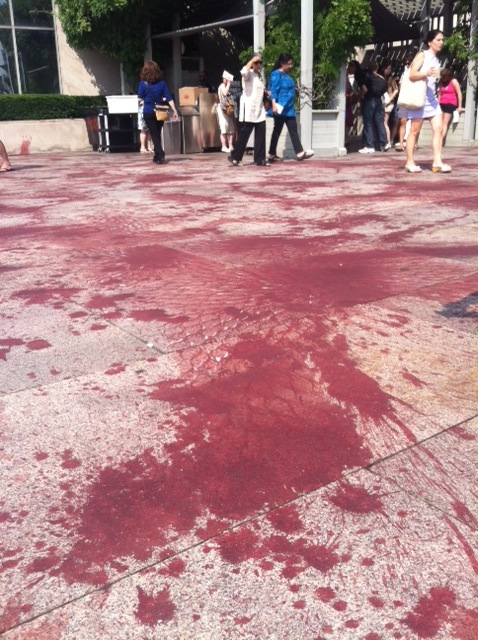
Imran Qureshi’s Roof Garden Installation, Metropolitan Museum of Art, New York, June 2013. Photo by Natasja Sheriff.
There are few public spaces for contemporary art in Pakistan. Sameera Raja has often said that instead of asking for the government to patronize the arts, it is the private sector that needs to step up. Ironically, the iconic painter Sadequain’s best work—his large murals—were commissioned by the government to be placed in public buildings such as the central bank or on a dam in Punjab.
Karachi’s Mohatta Palace Museum—a heritage site converted into an exhibition space—has hosted several important exhibits of contemporary artists, including retrospectives of artists like Sadequain. The museum currently features an exhibit by Rashid Rana.
Among Rana’s work on display is “Desperately Seeking Paradise” (2007-2008), a large steel cube that takes up most of the exhibition room. The piece is inspired by the Ka’aba, the pilgrimage site in Mecca revered by Muslims as the House of God and a household image across Pakistan. But this steel cube seems innocuous enough from afar until one steps closer. The steel frame is inlaid with panels featuring images of houses in Lahore and the skyline of neighborhoods in the city. This isn’t an iconic skyline: there are no skyscrapers and only a handful of recognizable monuments, so the skyline is formed of hundreds of thousands of houses meshed together. “You’re missing the best thing,” a gallery staffer calls out as I leave the exhibit. “You have to view it from a corner.”
I walk back and realize that the panels also form a skyline of high-rise buildings. As I walk around the cube, mimicking the movements of pilgrims as they walk around the Ka’aba, I can’t help but think about how Rana has interpreted the notion of pilgrimage in a modern-day context. Is this a comment on urbanization or a quick journey from the gleaming skylines abroad to the clusters of haphazardly built neighborhoods in Pakistan?
Even though the idea of the Ka’aba is staring right at me it doesn’t feel controversial. In Pakistan, we are often told the cautionary tale that attempting to create your own version of heaven will incur God’s wrath, or that pilgrimage is the only way one can feel closer to God.
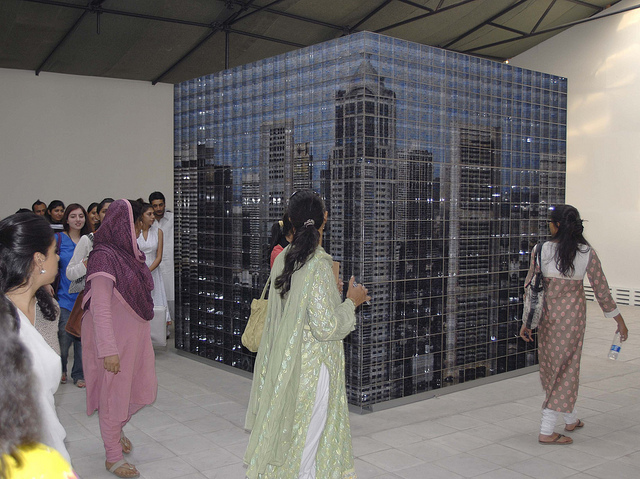
Rashid Rana’s “Desperately Seeking Paradise” (2007-2008) at Mohatta Palace Museum.
Photograph by Akbar Khushik, 12 Nov 2010. Image courtesy Mohatta Palace Museum.
But the idea that art in Pakistan can be controversial must have inculcated a sense of self-censorship in the community. I put the question to Raja, who says while it does exist, she doesn’t agree with it. “That should not be a reason to curb your creativity,” she said. “The fact is that nowadays artists don’t work for the heck of working, they’re thinking about ‘where should I show it?’, ‘who will buy it?’”
For some artists, this isn’t a question. Instead of exhibiting within the confines of art galleries and exhibit spaces, they’ve taken their work to the streets.
There is an expression in Urdu: “even walls have ears”. But in Pakistan, the walls don’t just have “ears”; they have their own history to tell.
Walls in this country—from shops to graveyards—usually feature hand-painted political party slogans with their one-line manifestos, hate speech against religious minorities, and advertisements from self-proclaimed “spiritual sages” promising cures for black magic curses to homeopaths claiming to have the answer to impotence. If the paint were scrubbed away, decades of this rhetoric, and a history of pop culture, would reveal itself in reverse as each layer came off.
So for some artists, the walls are the perfect canvas. One of the most well-known artists who used graffiti as a form of protest art was the late Asim Butt, who spray painted eject symbols on the walls of Karachi in 2007 as calls grew for General Pervez Musharraf to step down amid countrywide protests. He also defaced containers that are often used to block streets so protestors can’t pass through.
Graffiti artist Kala Boss (not his real name) says that “Living in Pakistan means you are constantly being exposed to some form of injustice or violence that is out of your control. I think that in this kind of environment it is very easy to become apathetic and turn a blind eye to everything as long as you are not directly involved. I saw this happening to me and wanted a chance to speak up. Not knowing how to go about it, I turned to the streets.”
While Rashid Rana’s exhibit depicting veiled women wasn’t shown in France (it was however, exhibited in Pakistan), Kala Boss took the veil to the walls. His work in recent years has included a woman in a burqa that was flapping up à la Marilyn Monroe, an image that went viral on the internet and now features on a line of t-shirts. It is also fairly ironic that the image appeared on public walls in some of Karachi’s most upscale neighborhoods, where many of its residents would deride a woman wearing a burqa as a ‘ninja’ or a hardliner. The image, for all of its shock value, also highlights that there is an actual, real, living and breathing person underneath the veil, not just another woman sheathed in black. His images have routinely appeared on the same walls only to be repeatedly painted over. One of the artist’s most talked about pieces of street art was a silhouette of a pregnant woman with a bomb in her belly; another featured the country’s map as a dinosaur.
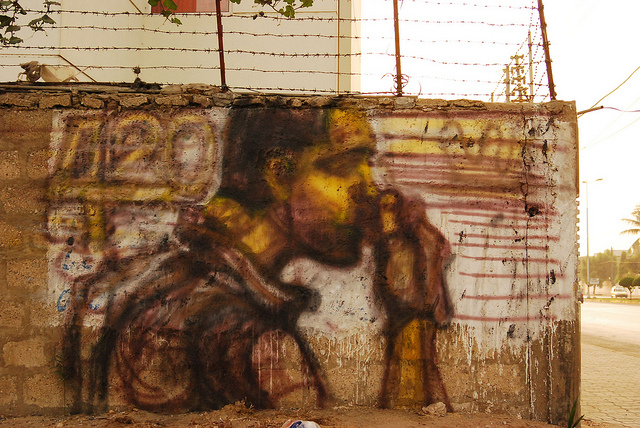
Asim Butt, “Something Rotten in the State,” (2009), unfinished. Spray paint graffiti. Sunset Boulevard, Karachi. Photo courtesy Mohatta Palace Museum.
While Kala Boss’ work has disappeared off the walls, replaced with advertisements and fresh coats of paint ready for more political party slogans, he said, “people are less likely to accept something on a roadside as art and therefore are less likely to treat it with any kind of respect. I personally don’t expect every single person to understand my work nor do I expect it to last very long. When putting something up in a public space you have to accept that it is no longer yours. The public will decide to do with it what they please. Some part of me actually likes it when my work is removed or vandalized because it means somebody saw it, understood it, and felt strongly enough about it to do something!”
Artists are now trying to promote graffiti and street art. This November, students at the Karachi University’s Visual Studies department took over several streets in a part of the city that is home to government buildings, the legislative assembly and court houses to paint murals on public walls, spray paint stenciled images depicting guns being thrown into trash cans, and put up posters in the central parts of the city depicting paintings of barbed wire, as part of a festival curated by a group of artists called ‘Pursukoon (Peaceful) Karachi’. The attempt, however, seems self-contained and lacks the spontaneity of work done by Butt or Kala Boss, a fact that organizer Nafisa Rizvi acknowledges. “This is also an art form,” she said. “What we did was simulated visual expression,” referring to the fact that there was an agenda attached to the graffiti and it was done in a controlled environment.
But while the work of street artists is routinely painted over, thanks to Kala Boss it lives on in a line of t-shirts. “Growing up in Karachi makes you very aware of the differences in classes, sects, religions and ethnicity’s of everyone living around you,” he told The Revealer. “I liked the idea of producing something that everyone could wear regardless of the differences that separated them; hence the decision to keep the number of designs limited and simple.” Over the past few years, scores of t-shirt companies have popped up in Pakistan offering designs that highlight their own, often sarcastic, interpretation of life in this country. Like the woman at the rally, perhaps there is a stronger desire to wear some form of political expression on one’s sleeve.
But apart from t-shirts and the odd coffee table book, there is little being done to document Pakistan’s contemporary art. In a country where archives are routinely dumped and thrown out, there is little hope that decades of art and political expression will be remembered once the walls are whitewashed again.
Saba Imtiaz is a freelance journalist in Pakistan. She reports on politics, culture, human rights and religion for local and foreign publications and is currently working on a book about the conflict in Karachi. Her work is available on her website, http://sabaimtiaz.com and she can be contacted at saba.imtiaz@gmail.com.
With support from the Henry R. Luce Initiative on Religion and International Affairs.
Featured image: Muhammad Ali, “Evanassence.” Image courtesy Canvas Art Gallery, Karachi.


